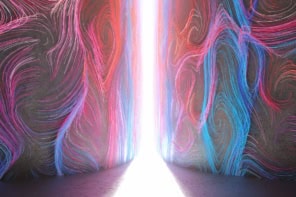Physicists in Finland have shown that it is possible to conduct heat over macroscopic distances at close to the maximum efficiency permitted by quantum mechanics. By directing photons along a superconducting waveguide, the researchers transferred heat between two resistors spaced up to a metre apart – some 10,000 times further than previously possible at the quantum limit. They say their technique could someday be used to cool chips inside quantum computers.
Quantum mechanics tells us that heat flow, like electric current, can be quantized. If a wire is so thin that an electron’s cross-sectional wavefunction can only assume one possible configuration as it travels along the wire, there is an upper limit to the rate at which electrical energy can be transmitted for any given voltage. Likewise, there is a maximum rate at which heat energy can be transferred along a single channel connecting a hot bath to a cold one when the baths are at given temperatures. This is the quantum of thermal conductance, which is reached when the hot bath emits energy perfectly, the cold bath absorbs perfectly, and there is no heat loss along the way.
For a hot bath at 1 K connected to a colder one at 0.9 K, heat will flow at 100 fW; one thousand trillionth of the output from a typical incandescent light bulb. Physicists have previously observed such “quantum-limited heat conduction” in a variety of physical systems; in 2013, for example, researchers at the CNRS Laboratory for Photonics and Nanostructures in Paris saw it in an electronic point contact sitting in a 2D electron gas. To date, however, such observations have been limited to distances of up to 50 μm.
Photon carriers
In the latest work, Mikko Möttönen and colleagues at Aalto University extended the quantum-limited distance to macroscopic scales by using photons, rather than electrons, as heat carriers. Maximum conductivity requires that heat carriers travel unimpeded along the thermal channel, but electrons, being electrically charged, can only go a very short distance along normal metals before they scatter off phonons, other electrons or material defects. Photons, in contrast, do not interact with one another – and if an appropriate transmission medium is used, photons will not interact with their surroundings.
The Finnish group carved a spiral-shaped superconducting waveguide into a small silicon chip, and connected each end of the waveguide to a metal resistor, which serves as a heat bath. Thermally induced voltage fluctuations across one of the resistors generate microwave photons that travel along the waveguide with a specifically shaped transverse electric field. The value of each resistor is tailored to exactly match the impedance of the waveguide and therefore minimize the number of photons reflected at the interfaces.
Möttönen and team cooled down the electrons in one of the resistors and measured the subsequent temperature drop in the other, using superconducting tunnel junctions as extremely sensitive thermometers (they decided to cool, rather than heat, the first resistor, to avoid skewing the temperature reading of the second with stray heat). Carrying out the experiment with two lengths of waveguide – 20 cm and 1 m – and operating at a temperature of about 0.1 K, they compared their measured temperature changes with predictions from a detailed thermal model they had developed. They found that their set-up reached between 80% and 110% of the theoretical maximum.
Quantum cooling
According to Möttönen, this technology would be well suited to cooling or initializing quantum devices, which need to operate at or close to the single-quantum level. Placing the cold bath far from the device being cooled down would minimize damage to the latter’s delicate quantum states while keeping the former cold, he explains.
One possible application, he says, would be very sensitive radiation sensors that need to be set to zero as precisely as possible before making any measurements. But probably the main use for the technology, he believes, would be in quantum computers, whose bits change state when absorbing even very tiny amounts of heat. He points out that some groups are now testing error-correction on qubits, but notes that these experiments rely on post-selecting only those qubits that started out in the correct state. “In an actual quantum computer, when you want to do a specific calculation you need precise initialization,” he says.
The research is reported in Nature Physics.



